Written by Stuart J. Murphy, Author of the MathStart Series (HarperCollins)
The Children’s Book Review | August 11, 2015
“What Einstein was able to do was to think visually.”
—Walter Isaacson, “Einstein: His Life and Universe”
Are your kids having trouble understanding a new math concept? Could they use a brush up on what they learned last year? Are they (and are you) ready to have some fun with math?
My MathStart books combine stories and visual learning strategies to teach children mathematical concepts. Children love stories and even the youngest are accomplished visual learners.
Educators Thomas Rowan and Barbara Bourne wrote in Thinking Like Mathematicians : “Research has shown that Visual Learning is especially appropriate to the attainment of mathematics skills.”[1] Since the publication of this book, evidence has continued to grow in support of the use of visual learning strategies in the teaching of mathematics.
So what exactly is visual learning? In a nutshell, it leverages information presented through illustrations, photos, diagrams, graphs, symbols, icons, and other visual models to help make sense of complex data. There are five key visual learning skills:
- Observation
- Recognition
- Perception
- Interpretation
- Self Expression
It is important to put these skills into action through the use of specific strategies that will help students see the math. Here are some examples:
Visualize Relationships
Help students to look for and identify patterns and relationships between numbers.
Missing Mittens is a story about odd and even numbers. Even numbers line up in sets of two. Odd numbers always have one left over. It’s a pattern!
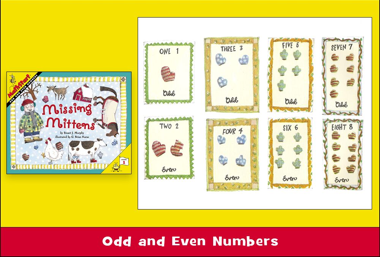
When visually explaining how to double a number, always show the two sets that make up the new total rather than massing the numbers together. In Double the Ducks, six sacks of food are shown as two sets of three.
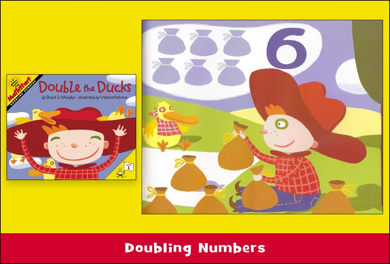
Once students understand a mathematical relationship, it is much easier for them to see more complex patterns. Spunky Monkeys on Parade is a story about counting by 2s, 3s and 4s. Sets are presented in countable arrays, making it easy for students to see the patterns and figure out what the next number in each set will be. It is a skill that lays the foundation for learning multiplication.
Sketch Out New Concepts
One of the most powerful visual learning strategies is having students sketch out a new math concept themselves. Rowan and Bourne observed: “Understanding abstract math concepts is reliant on the ability to ‘see’ how they work, and students naturally use visual models to solve problems.”[1] From tally marks for keeping track of quantities to drawings for solving word problems, kids are more likely to “get” what they can see.
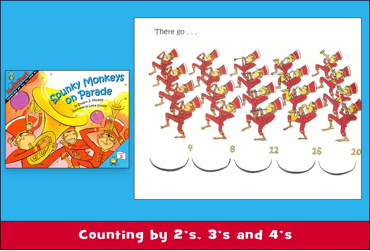
For example, division problems with remainders can be tricky. In the story Divide and Ride, 11 best friends are spending the day at an amusement park. They are about to go on the Satellite Wheel, a ride where each chair can fit three children and every chair must be filled before the ride can start. It is easy to see the relationship between multiplication and division: Four chairs times three children each equals 12 children. Conversely, 12 children divided into four chairs equals three children per chair. But what happens if you have 11 children? Divide 11 by 3 and the answer is 3 with a remainder of 2. To solve the problem, the friends make a new friend, inviting another child in line to join them. Now they are 12!
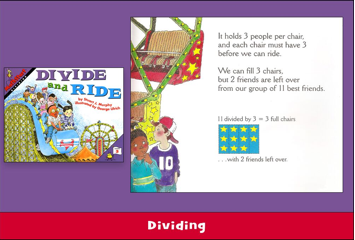
Create Charts and Graphs
Bar graphs are powerful tools for seeing and understanding data relationships. In my story Lemonade for Sale, kids set up a lemonade stand to raise money to fix up their clubhouse. Each day, they chart the number of cups sold. They can quickly compare the numbers to see which days they sold the most and the fewest number of cups and analyze that information to make a key decision.
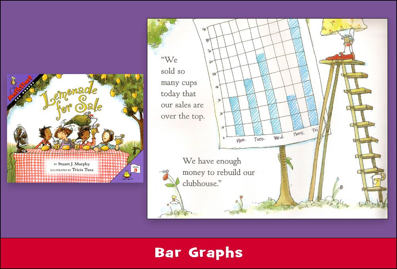
In Less Than Zero, young Perry the penguin, who has his heart set on buying a new ice-scooter, uses a graph to chart his progress. Unfortunately, after he borrows some “clams” for a fishy float and other fun things, he goes into debt and has to learn how to deal with negative numbers.
Make Estimates Visually
“Students’ consideration of size and their visual comparisons of near and far objects are vital to their understanding of estimation,” wrote Swiss developmental psychologist and philosopher Jean Piaget in The Child’s Conception of Geometry
The two friends in the story Betcha! love to challenge each other estimating everything from the number of people on a bus to the number of jellybeans in a jar. Being able to create visual models turns out to be a winning strategy!
Summary
Whether learning to make sense of mathematical problems or trying to grasp new math concepts, using visual learning strategies can help students reach their goals. Visual representations, models, and diagrams allow them to see the math. One of eight key teaching practices listed in NCTM’s Principles to Actions: Ensuring Mathematical Success for All, states: “Effective teaching of mathematics engages students in making connections among mathematical representations to deepen understanding of mathematical concepts and procedures as tools to problem solving.”
The evidence is there: Using visual learning strategies to teach mathematical concepts works.
About the Author
Stuart J. Murphy is an author of children’s books and a visual learning strategist. He is the author of the award-winning MathStart series (HarperCollins Children’s Books), 63 books that present mathematical concepts in the context of stories for Pre-K through Grade 4. Stuart is also the author of Stuart J. Murphy’s I SEE I LEARN (Charlesbridge), a 16-book series of storybooks for children in Pre-K, Kindergarten, and Grade 1 that focus on social, emotional, health and safety, and cognitive skills. The series is also published as Stuart J. Murphy’s I SEE I LEARN at School (Pearson Education). The comprehensive program includes classroom posters, videos, digital games, teacher guides, school and home activities, and other support materials for teachers. He is on the authorship team of a number of mathematics programs published by Pearson Education. Most of all, Stuart is an advocate for helping our children become more successful learners.
For more information, visit: http://www.mathstart.net
If you enjoyed this article: Seeing the Math: Visual Learning Strategies for Mathematical Concepts, discover more article and books by checking out our posts with these tags:
